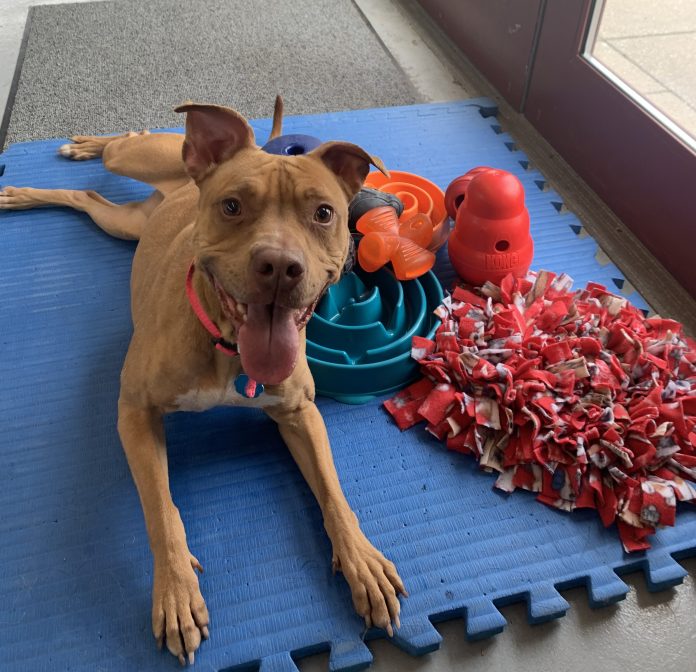As COVID-19 restrictions finally lift, many of those who have worked from home since March 2020 are returning to the office.
This shift back to uncomfortable desks, conference room meetings and rush-hour commutes is something most employees weren’t looking forward to. But their annoyance over trading in sweats for dress pants is nothing compared to the feelings of someone else – their beloved pets, who had their favorite human as company all day, every day, for the past year.
According to Jennifer Bragan, canine behavior education coordinator and certified dog trainer at Women’s Animal Center in Bensalem, dogs, cats and other animals may experience separation anxiety, which can range from mild to intense cases.
“People have been nestled up with their pet in their home office this whole time, and now that’s going to come to a screeching halt,” said Bragan.
In order to ease pets into spending time solo while their owner is at work, Bragan recommended they do a test run prior to returning to the office full-time. The owner can set up a monitor, leave the house, and then see how their pet responds. In mild cases of separation anxiety, Bragan said the animal will show a little distress but then settle into the idea of having their person gone.
“If you see some signs of distress that are a little more pressing, if your dog can’t settle, they’re pacing, they’re panting, they look like they’re really having a hard time with it, that’s when you would want to seek veterinary care through a veterinary behaviorist,” said Bragan. “They can help you address those problems.”
When a pet owner has a set date to return to the office, Bragan urged them to adopt that schedule in the home a few days or weeks ahead of time. For example, if breakfast is moving from 8 a.m. to 6 a.m. to account for travel, the owner should get themselves and their pet used to this routine while still working from home. Bragan stressed that animals thrive on predictability. Additionally, a little morning exercise, whether it’s a walk or playtime in the yard, can help ease anxiety.
“If you’re seeing mild symptoms, or if you’re just worried about it, it’s good to start that routine now and get them into that pattern,” said Bragan.
Separation anxiety isn’t exclusive to dogs and cats. It can include birds, such as parrots.
“Anything that’s socially bonded to us seems like they really struggle sometimes,” said Bragan.
Jack Griffin, director of shelter services at Women’s Animal Center, explained that severe separation anxiety is distress and should not be taken lightly.
“They can really do a lot of self harm. When you’re talking about birds, they can pluck their own feathers out. Dogs can do a lot of self harm with chewing through doorways,” he said. “People who don’t suffer from anxiety don’t think of it as being a severe condition and it sounds not that bad. But separation anxiety can really be distress and self harm. For me, it’s the saddest behavior problem that I’ve dealt with. They’re almost always nice dogs and they’re suffering.”
While staff at Women’s Animal Center can train dogs that have one-off outbursts of anxiety, for example if they’re overstimulated on a walk, WAC isn’t equipped to handle those more serious cases. However, Bragan is always happy to provide resources and contacts for owners who don’t know where to turn.
For pet owners who have no plans to return to the office anytime soon, Bragan said it’s still helpful to remind their animals how to function without them for a few hours.
“The more normal of a schedule you can keep, the better,” said Bragan. “Maybe your pet can spend the morning with you curled up at your feet while you’re working on stuff, and then after lunch they can spend a little time in another room away from you being calm.”
During these alone hours, Bragan said owners can set their pets up for success by giving them something to do. Food dispensing toys for kibble and slow feeder puzzles can be great boredom busters for furry friends. They also help dogs and cats tap into their foraging instincts.
Women’s Animal Center, located at 3839 Richlieu Road, is currently celebrating its 152nd anniversary. Its services include animal sheltering and adoptions, dog training, physical rehabilitation, youth programming and veterinary care.
Though most of these offerings slowed during the COVID-19 pandemic, especially since there were fewer stray animals to take in, WAC remained open to care for the ones who couldn’t be fostered out as well as any sick pets in the community.
Call 215-750-3100 or visit womensanimalcenter.org for more information. ••





